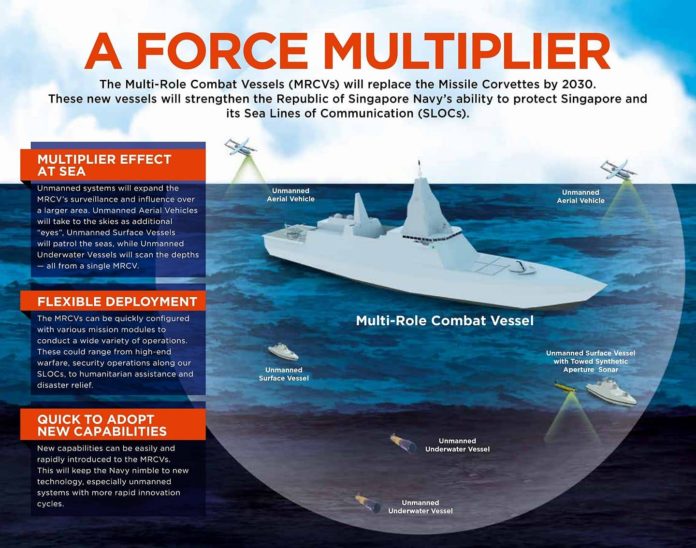SINGAPORE: The action starts far away, some 100km from the mothership. The enemy does not see the unmanned aerial vehicle (UAV) loitering high in the sky, let alone the mothership itself.
But the UAV sees the enemy. Its high-definition, high-zoom cameras – powerful enough to see the features on your face – easily identify the enemy: A hostile speedboat carrying armed men.
The images are quickly transmitted to the mothership. Inside its command centre, an operator dispatches yet another robotic weapon: A missile-equipped unmanned surface vessel (USV) slips out from the side of the ship.
The USV charges forward and tracks the enemy. The speedboat doesn’t get close – not within 10km of the mothership – when the USV locks on and destroys it.
Based on a video shown at this year’s International Maritime Defence Exhibition and Conference (IMDEX) Asia held in Singapore, this is how a combat scenario could play out when a mothership works with a team of unmanned boats and drones, making it possible for navies to see earlier and strike faster.
Last June, Defence Minister Ng Eng Hen announced that the Republic of Singapore Navy (RSN) will replace its ageing missile corvettes with the multi-role combat vessel (MRCV), a type of mothership carrying unmanned platforms for the air, surface and sub-surface.
“They will have … a modular package to extend their reach and flexibility against threats,” he reiterated in March during the Ministry of Defence’s (MINDEF) Committee of Supply speech.
The first MRCVs will be delivered around 2025, with full delivery expected by 2030.
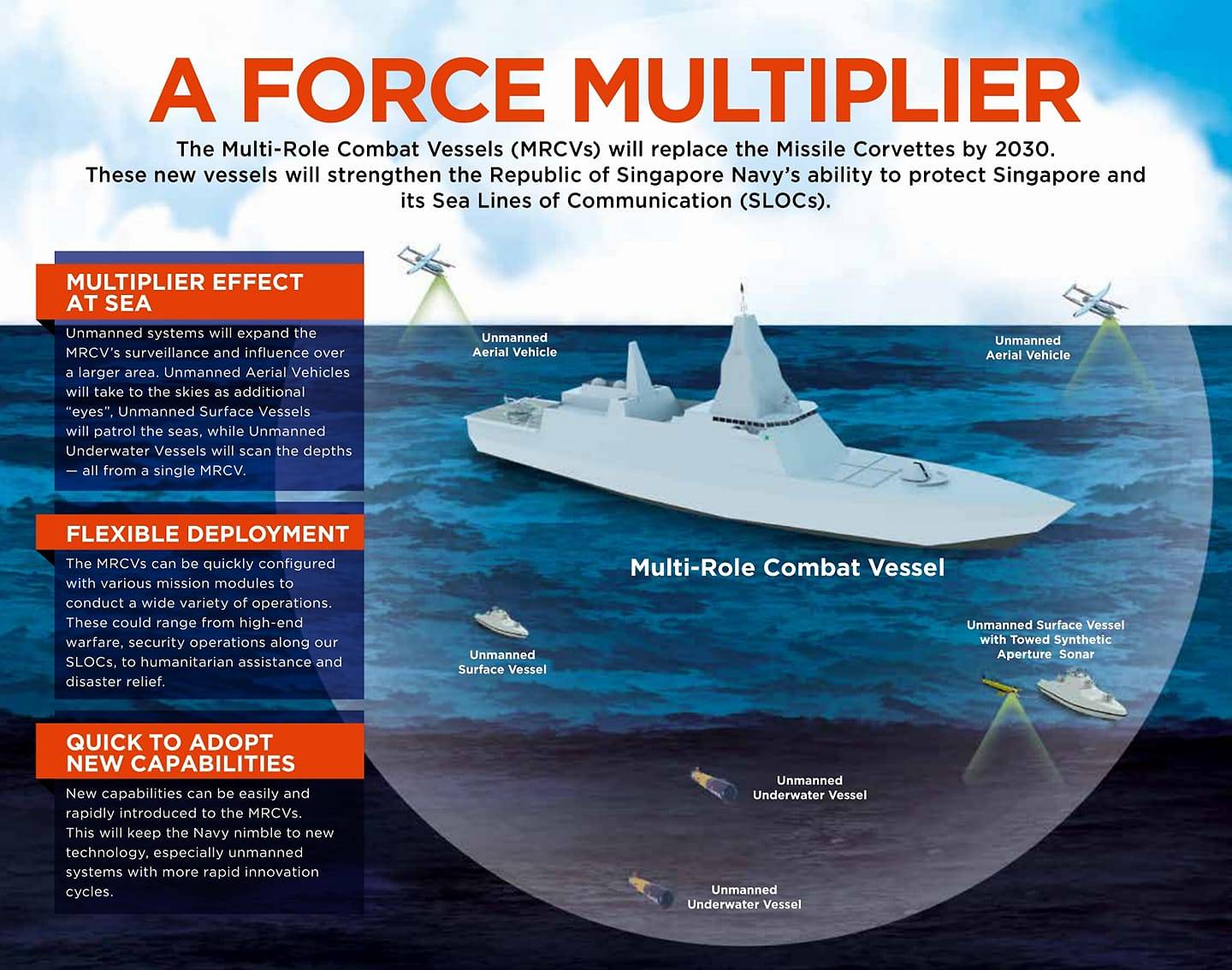
The Republic of Singapore Navy’s multi-role combat vessel. (Graphic: MINDEF)
The mothership concept is not new. The US Special Operations Command has deployed a mothership that can carry massive loads of military platforms, supplies and gear, while the UK Royal Navy is developing multi-role ships capable of conducting a variety of operations, including crisis support and warfighting.
And so to find out just what a mothership can do, CNA spoke to defence companies at the biennial IMDEX Asia, featuring more than 230 companies from 29 countries. The May 14 to 16 event included defence giants like America’s Lockheed Martin, Israel’s Rafael and Italy’s Leonardo.
The first stop was a gleaming mega exhibition stand right by the entrance: Singapore’s defence conglomerate ST Engineering.
UNMANNED SURFACE VESSEL
One USV that could be paired with a mothership is ST Engineering’s Venus 16. The RSN has tested the Venus 16 from as early as 2015, when it was used during a maritime exercise to chase suspicious vessels.
MINDEF also revealed in March that the RSN was developing three types of USVs to counter mines and conduct coastal patrols. In the latter role, the USVs will eventually replace RSN’s littoral mission vessels, allowing the ships to be deployed farther and more strategically for complex missions.
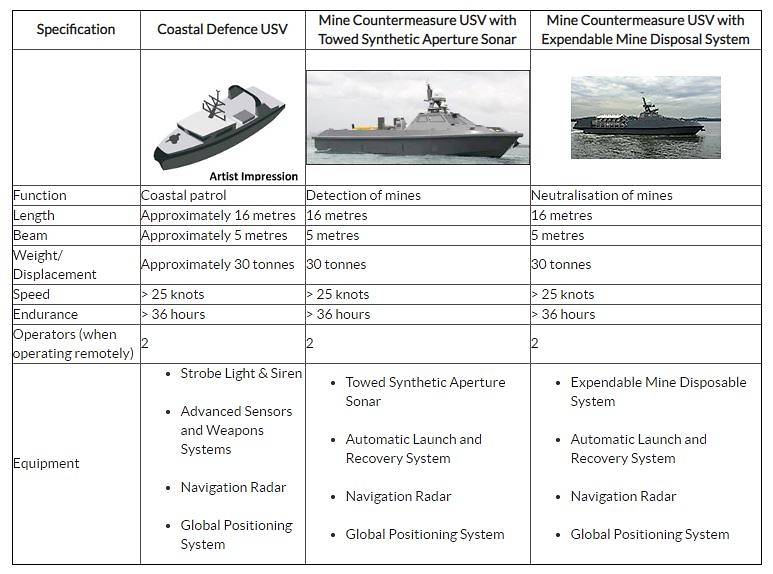
The RSN is developing three unmanned surface vessels that can perform their tasks “at much lower cost and with less manpower” than manned platforms. (Table: MINDEF)
What makes the Venus 16 suitable in a mothership system is its size and ability to play multiple roles, industry players said.
Its 16m length means it is small enough to fit in a mothership, yet big enough to carry a remotely operated gun for force protection and an additional payload depending on the mission. Size also matters when navigating choppy seas and carrying enough fuel to stay out longer.
For mine clearing missions, a Venus 16 can be fitted with a towed sonar to detect mines, while another can carry an expendable robot to dispose mines. For anti-submarine missions, a dipping sonar can be attached to detect submarines ahead of the mothership.
“Our design is so flexible that the same platform can be used to integrate different types of payloads,” ST Engineering vice-president, marine technology and solutions Ng Tee Guan told CNA.
Dr Ng said the Venus 16 unmanned surface vessel helps “reduce risk exposure for soldiers and improve manpower efficiency”. (Photo: Facebook/Ng Eng Hen)
The Venus 16 can also be used for patrols and search and rescue, said Ho Kah Tong, ST Engineering vice-president of unmanned maritime systems, large-scale systems group.
Operators can plot a circuit and go hands off as the boat automatically plies the route and avoids obstacles, all while using day and night cameras to send information back to the mothership.
The various unmanned boats and drones that could potentially fit in a mothership system.
When the Venus 16 is in open sea and there’s not enough communication bandwidth to send huge amounts of imaging data, its sensors can choose to only relay basic identification data, like the shape of a structure or the type of a ship.
Back at the mothership’s command centre, a visualisation engine will use the data to reconstruct 3D video showing what’s around the Venus 16. This lets operators see buildings on shore or a warship passing by, allowing them to maintain situational awareness.
But Mr Ho said the visualisation engine is still under development as it requires a lot of artificial intelligence and machine learning.
AUTONOMOUS UNDERWATER VEHICLE
With the sea surface covered, the attention now turns to the sub-surface.
One possible unmanned underwater system for a mothership is ST Engineering’s Mercury autonomous underwater vehicle (AUV), designed to scan the seabed for mines.

The Mercury autonomous underwater vehicle can carry high-frequency and dual-frequency synthetic aperture sonars. (Photo: Aqil Haziq Mahmud)
With its integrated sensors, the Mercury can navigate and detect mines in congested waters better than mine-countering USVs, which move with a sonar in tow. The Mercury is also designed for shallower waters, where currents are stronger and mines are usually deployed.
“When you’re at the 10m-depth region, that’s where you have surface wash and underwater currents, sometimes in different directions,” ST Engineering deputy department manager, maritime comms and systems division Jay Poh told CNA.
“So, these kinds of counter dynamics make stability an issue. But we have perfected this AUV, tested it for more than seven years in Singapore.”
READ: ‘Submarines like BMWs’: A closer look at the Navy’s newest, custom-made German submarine
Besides countering mines, the Mercury can be used for harbour security as well as search and salvage operations. Future applications include anti-submarine warfare.
“We are payload agnostic,” Mr Poh added. “Depending on concept of operations, we can then work with payload suppliers to package within our form factor.”
READ: Meet the Republic of Singapore Navy’s new poison shrimp. They even call it ‘Invincible’, a commentary
The Mercury’s intentionally small diameter also allows it to fit common ship configurations and be deployed from any ship with a one-tonne crane. Launch and recovery is remotely driven using a portable 10-inch tablet.
UNMANNED AERIAL VEHICLE
When it comes to pairing motherships with UAVs, the RSN has already done so with its missile corvette and ScanEagle, effectively extending the ship’s vision by about 100km.
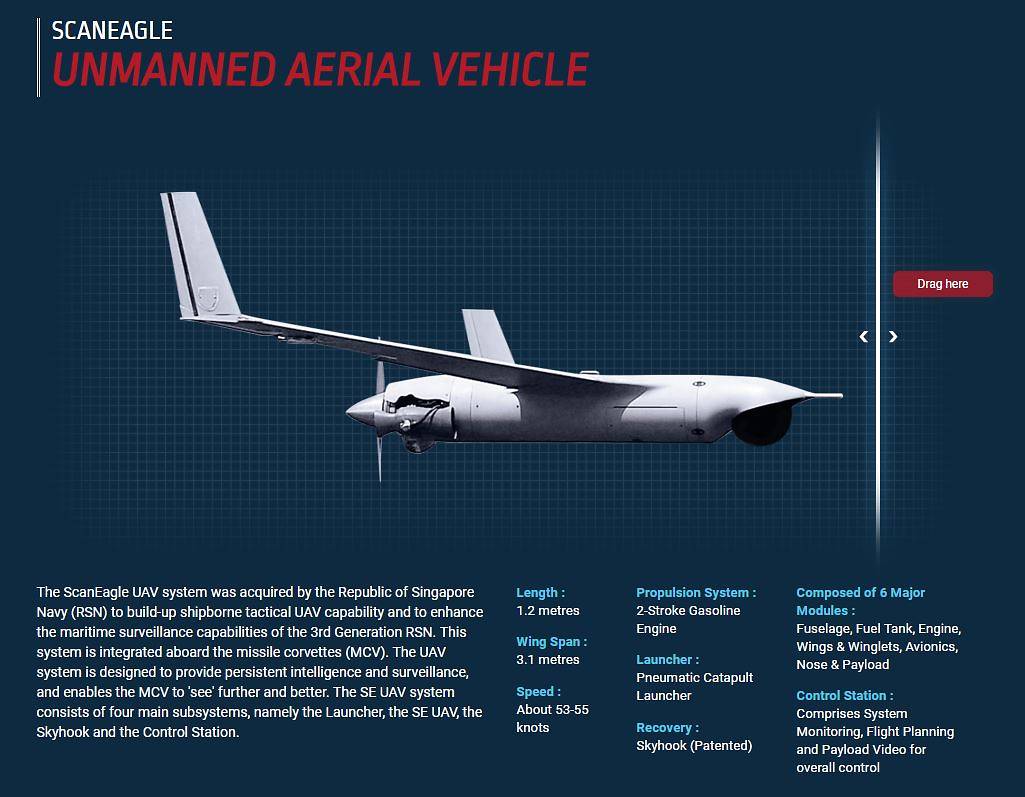
Three of the RSN’s missile corvettes are equipped with ScanEagles. (Graphic: Republic of Singapore Navy)
But the ScanEagle, by Boeing-owned UAV manufacturer Insitu, is already into its third iteration. According to Insitu’s website, the ScanEagle 3 has double the payload capacity to collect and analyse more data in a single flight.
An Insitu spokesperson was unavailable for comment when CNA visited its booth at IMDEX 2019.
However, another industry player said major navies buying new frigates or corvettes are choosing to pair them with bigger and more robust UAVs that can see even farther.
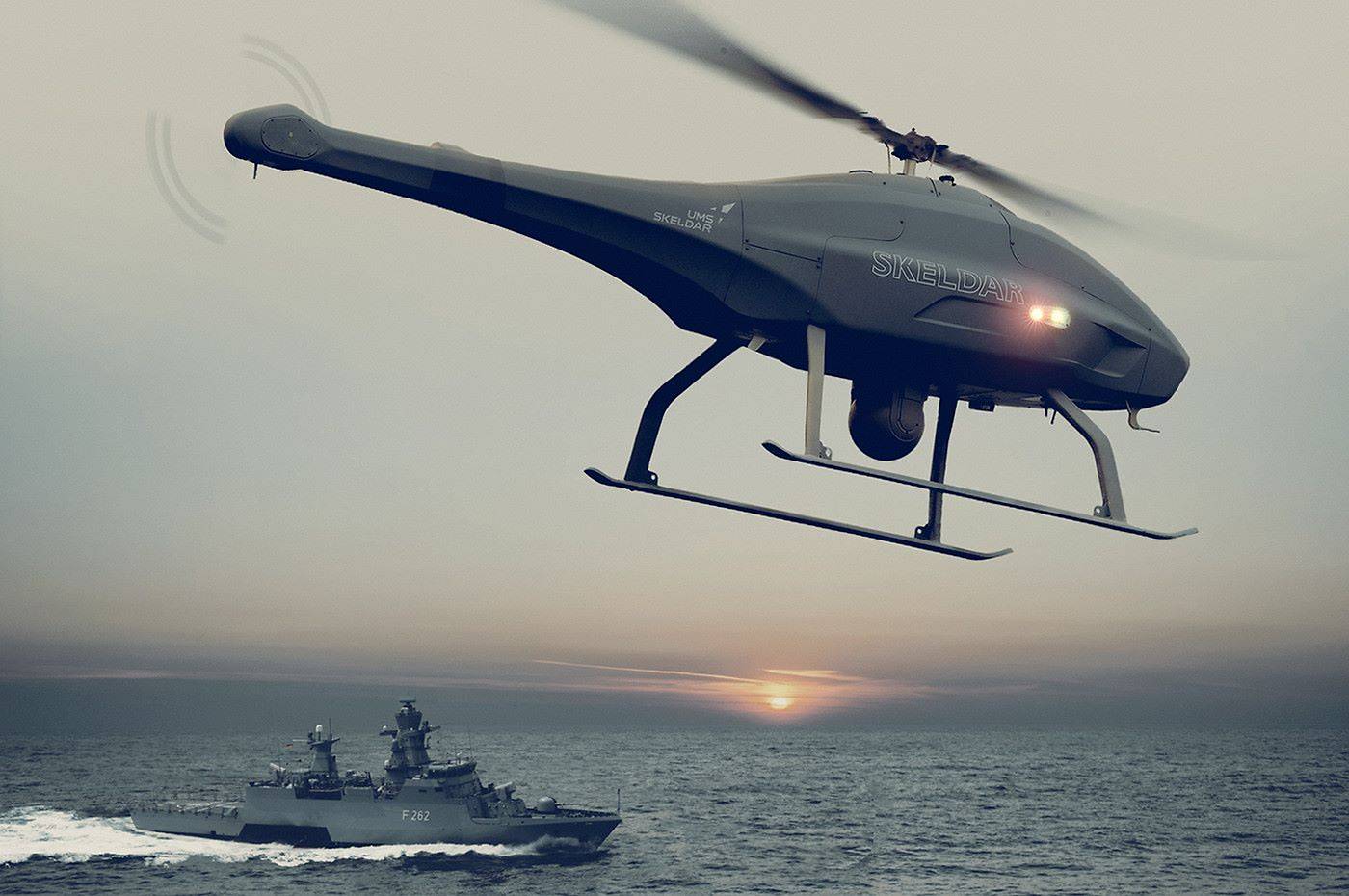
The Skeldar V-200’s payload can include a ground moving target indicator radar, hyper-spectral cameras and ViDAR, a type of radar that covers much more area. (Photo: Facebook/Saab Australia)
One such option is the Skeldar V-200, a helicopter-like UAV that carries more high-performance sensors and transmitters to send information from as far as 200km away.
“If you are meeting a threat who has a system like this, they would have a direct advantage over you,” said Richard Hjelmberg, executive sales director at UMS Skeldar, a joint venture involving Swedish defence company Saab. “They would see you before you see them.”
Beyond its superior surveillance capabilities, the Skeldar-V200 can also take off and land vertically and autonomously, all with the push of a few buttons. No bulky launch and recovery equipment is needed; only a conventional helipad fixed with a rubber pad and auto landing sensors.
“From landing, it takes only 30 seconds until the rotor stops,” Mr Hjelmberg added. “So, it’s easy for the ship’s crew to moor it down or take it into the bay.”
THE MOTHERSHIP
And then there’s the mothership itself.
At IMDEX 2019, ST Engineering unveiled its Vanguard 130, a multi-role warship capable of deploying a wide array of unmanned systems like the USV, AUV and UAV.
In a media release, the company described the ship as a “good fit for ship operators looking for enhanced cost efficiencies and flexible ship deployment”.
Compared to modern frigates, it can also operate with a “quite significant reduction” in manpower, ST Engineering senior vice-president, engineering design centre Mathai Pambrakaran told CNA.
The Vanguard 130 is a multi-role combatant capable of deploying unmanned systems and weapons like surface-to-air missiles, anti-ship missiles and torpedo launchers. (Graphic: ST Engineering)
Mr Pambrakaran said the ship can carry two Venus 16 USVs, two Mercury AUVs and two ScanEagle UAVs. It also has a mission bay capable of holding smaller USVs and manned boats.
USVs and AUVs can be deployed from flushed doors on the side or a ramp at the rear, while UAVs can vertically take-off or be launched from a helipad on the aft deck.
“We have manned and unmanned teaming, and this platform is acting as a hub to coordinate those kind of activities,” he added, noting that the ship can use all-dimensional weapons to deal with threats from the sea, air and underwater.
The Vanguard 130 will also use a phased array radar which doesn’t spin like conventional radars, eliminating moving parts and reducing maintenance costs. “We use a lot of new technology on this platform,” Mr Pambrakaran stated. “Cyber security, data analytics – it’s an intelligent ship.”
A DIFFERENT VIEW
But the mothership concept has its limitations.
One industry player said the launch and recovery of USVs from motherships is “inherently dangerous and difficult”, especially if sea conditions are extremely rough. Furthermore, operators on the mothership would have an extra task of monitoring unmanned systems.
“Here you are looking at the other pictures – doing surveillance, anti-submarine warfare – and you still got to worry about two USVs which you just let go six hours ago,” said James Soon, president of local USV manufacturer Zycraft.
For patrol missions, USVs which use conventional radio communications are also limited by the distance from which they can send information back, he stated, noting that it’s not very strategic for them to be so close to the mothership.
“If you are a mothership and you are sending a USV 12 miles out, 12 miles is still within the radar horizon of the mothership,” he added. “Why do you go so far out just to launch a boat that goes another 12 miles out?”
The Vigilant independent unmanned surface vessel comes with a gyroscopic stabiliser to move steadily through rough seas. (Photo: Aqil Haziq Mahmud)
Instead, Zycraft’s Vigilant USV uses satellite communications, meaning it can conduct surveillance from almost limitless distances. It also uses a smaller engine and propulsion system that burn fuel slower, so it can stay out at sea for 25 days at slower speeds.
But because the Vigilant is about 17m long, Mr Soon said it would not fit in most motherships – not like he sees the need to.
“If I want to send a USV to operate 200 miles from Singapore, why do I have to use a mothership? I can drive the USV there and leave it there for 20 days,” he added.
ST Engineering is also developing the 45m-long, long-endurance USV (LEUSV), which it said can stay out at sea for more than 45 days. (Graphic: ST Engineering)
Mr Soon believes that a USV with the right size – not too small that it can’t hold much, but not too big that it can be spotted from far away – can be an effective warship killer when operated from land.
According to Mr Soon, a 17m-long USV like the Vigilant has enough payload space to hold a substantial amount of fuel and small missiles with a range of about 10 miles (16km).
“We can see a warship at 10 miles, we can take out a warship at 10 miles,” he said, noting that a warship’s guns would not be able to reach that kind of range, while its missiles would likely not be wasted on low-value targets like USVs.
“They won’t know it’s coming, and by the time they realise it’s coming, it’s too late.”
